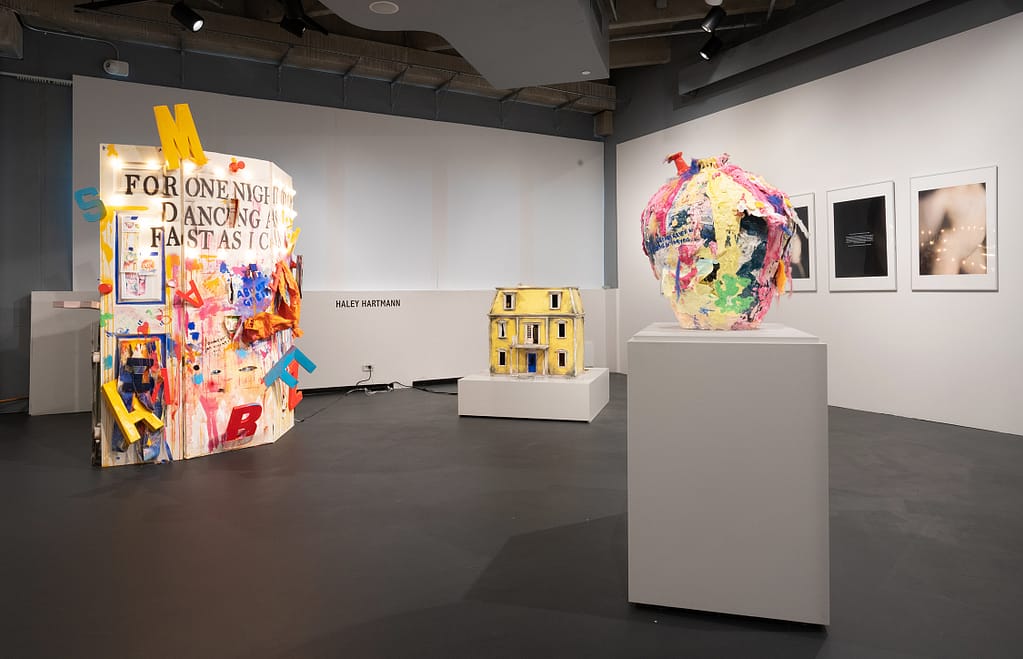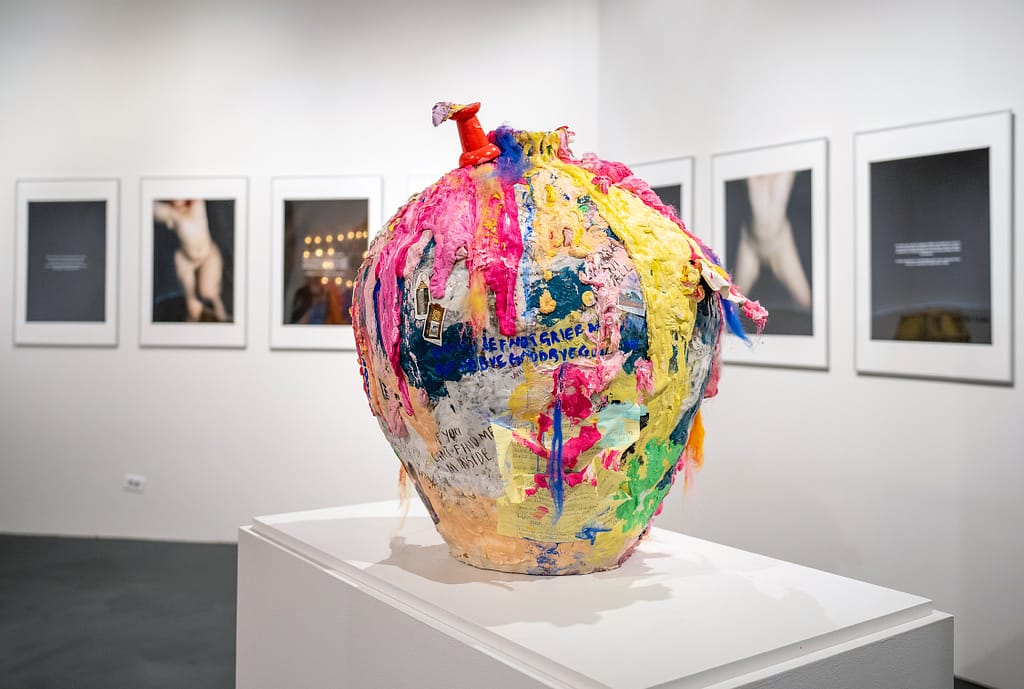
A Vessel Large Enough for me to Spend the Rest of my Career in


Stoneware, joint compound, photographs, found text, automatic writing, a poem written every month for a year, a letter, a giant thumb tack, three porcelain eggs, masking tape, a stoneware nose, a stained-glass doll house window, a paper weathervane.
For One Night and One Night Only, Dancing as Fast as I can


String lights, acrylic paint, watercolor paint, BLACK 3.0, crayon, house paint, spray paint, acrylic letters from the Simphiwe Ndzube exhibition at the Denver Art Museum, cardboard letters from Deborah Howard, EASY KLEIN – IKB INCREDIBLY KLEINISH BLUE ACRYLIC PAINT, on closet doors
I am chasing conduits for meaning through interdisciplinary work. Each new work considers its content first, and the form is discovered as a vessel to convey that content. This body of work seeks to explore Americana three ways: One, the nostalgia embodied by the gutted shells of themed diners or the wooden lamp posts covered in staples and nails and tape but no signs, a nostalgia that locates itself somewhere deep in the heart of the Midwest. Two, the physical detritus of Americana, the fried eggs, the copper pots and pans, prescriptions for anti-psychotics, teeth pulled with the root intact, a Sunday morning newspaper, the relics of a traditional American upbringing. Three, the way that language and artifact strain to make meaning out of themselves and each other. A building collapses, it is in the paper, a building is built, it is in the paper, a building collapses, again, again, again. Dream House holds the most literal embodiment of Americana. A yellow colonial style home houses rooms filled with the horrors of the residual cultural imprint from an American-style-upbringing. Ghosts haunt the halls, crimes are concealed or laid bare, dichotomies are cut, absences are made visible, and façades are upheld. A Vessel Large Enough for me to Spend the Rest of my Career in touches on the personal fallout of an idealized coming of age narrative. The vessel, large enough to hold the artist in fetal position, houses inside itself a ball pit, a letter to a lost friend, a history of the last year, and imagery from a broken, melting Americana. For One Night, and One Night Only, Dancing as Fast as I can is a panel painting that advertises a grotesque performance. A three headed figure rides a cramped tricycle on the stage while clown-like visages push forward from behind the painting. The back of the work reveals the undisguised chords of the marquee lights as well as a path that leads to the Dream House. Each work houses an embodied experience of Americana and bursts with the artifacts and personal fallout of those experiences.
Dream House



Model train houses, miniature pots and pans, 3D printed furniture, miniature lighting fixtures, a miniature extension cord, BLACK 3.0, pharmacy receipts, miniature mirrors, fake blood, a miniature oven, a miniature queen bed, a ghost, an angel, a miniature bible, a miniature dictionary, a miniature blue canvas, a miniature bunk bed, prescriptions for anti-psychotics, gold leaf, joint compound, miniature bananas, a miniature refrigerator, a miniature sink, a small porcelain egg, miniature forks and knives, a miniature knife sharpener, one hundred porcelain teeth, on doll house.
A Midsummer’s Wet Dream








Abstract Artist’s Book
Something that started as a sort of introspective engagement with family and moving home and maybe gender and turned over the course of ten or so relatively brutal weeks into a desperate and successful bid to play in earnest with things that make me happy (Untitled in three acts)

Acrylic, joint compound, crayon, house paint, and film transfers on doors
Something that started as a sort of introspective engagement with family and moving home and maybe gender and turned over the course of ten or so relatively brutal weeks into a desperate and successful bid to play in earnest with things that make me happy (Untitled in three acts) is a work that literalizes the act of storytelling. Abstract forms and found textual elements function in the same way those elements function in theatre—grappling with and for the attention of the audience, holding briefly and relinquishing back to the fullness of the narrative. Archetypes of character and place become confused with earnest representations of identity until the two are synonymous for one and another.
The scale, the gestural movement, and the literal forms found in the work evoke Works Progress era murals and the decades of innovative painting that followed. The style of abstraction is engaging both with Helen Frankenthaler’s field works, and Joan Mitchell’s playful abstractions.
The visage of the artist informs and engages with new dialogues burgeoning in response to rigid modernist theory. Coined as empathist theory, the work is deeply interested in the relationships that art has with context—explicitly the context of the work, the positionality of the artist, and the context of the viewer.
Similarly, the hybridity between art space, theatre space, and text space highlights the untapped potential of interdisciplinary work. The relationships that function simultaneously through the piece vibrate with a myriad of interconnected energies. Working as a scenic designer, painter, and carpenter directly influenced the scale of the work, and the text elements are pulled from a found journal that documents theatre lesson plans.
The turning point of this piece was the introduction of realistic eggs. A return to joy—intentionally and without faltering—breathed new life into the work and simultaneously allowed a deeper and more enjoyable engagement from an audience. The engagement with the piece is one of both reverence and play. The viewer circumnavigates the piece, following a walking pattern that is at first distant, then intimate, then cyclical as the act is repeated on the other side. This circling is a playful one, as the joy of an art object—evoked explicitly on the back through a huge egg on a yellow background—engenders childlike engagement with the work.
Following this work, I intend to set out making a series of books. These books will be composed predominantly out of abstract works, ceramic eggs, found objects, and whatever else arises, collaged as pages, but meant to be “read” in the same direction and pattern of a traditional book.





















